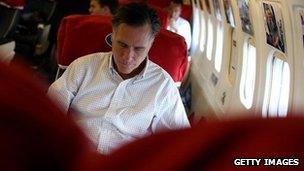The strange Sandy-coloured campaign
- Published
- comments

Mitt Romney - en route to Illinois
When the day began it was almost a normal campaign here in Ohio; now, with huge winds and rain lashing down, what became the strangest campaign in modern history has ground to a halt.
As Mitt Romney wound up his speech at Avon Lake High School, word went round the media pack, penned in behind barriers from the crowd of bellowing supporters, that his campaign was cancelling any more events on Monday, suspending for Tuesday as well.
It seemed a logical response to the oncoming storm; in the same way that the Republican National Convention delayed its start because of a tropical storm travelling up the Gulf Coast, it was inconceivable that Mr Romney should continue campaigning while death and destruction was wreaked upon the Atlantic Coast.
The rally was fascinating; the crowd of around 3,500 was seriously fired up, whooping and applauding at every mention of Mr Romney's name. Chatting to Republicans beforehand, there wasn't hysteria about their prospects, but real confidence that things are moving their way - a sea-change from a week before the first presidential debate, when Republicans I talked to were already plotting whom to blame when they lost the election.
As is so often the case with Republican gatherings, the crowd was overwhelmingly white, and predominantly middle aged (or older). There's nothing wrong with that in itself - I plead guilty to both. But it is noticeable that in one of the most heterogenous societies on Earth, the Republican party attracts almost no overt support from ethnic minorities and fails to attract a whole lot of interest from those under the age of 40.
As for Mitt Romney, he seems curiously unaffected by the enthusiasm which now surrounds his campaign. Within minutes of him turning up on stage, the students who had come for a look at the man who may be the next president of their country were chatting to each other or checking their phones.
Mr Romney gave his standard stump speech, laying out - eight days before the vote - not a vision of what the US might be like under his leadership, but instead how he would cut corporate tax rates and scrap deductions and loopholes to pay for it.
But Republicans seem unfazed by their resolutely wooden candidate. And swing voters don't appear to mind too much either - indeed, some like the fact that the high rhetoric and lofty promises of the 2008 campaign have been replaced, at least by Mr Romney, by a drier, more technocratic approach.
"Everyone says Mitt Romney is not a likeable person," Brian Leonard, a former Obama voter, told me in Chicago last week (you can hear the full report here, external).
"Well I'm not voting for Mitt Romney to be class president. I'm voting for him more because we need to get things done."
It all seems a bit underwhelming given the scale of the problems that America faces, and the importance that both sides ascribe to the upcoming vote; but that's the campaign that the country has right now.
Or had, until Sandy roared in. The campaigning is not quite over. Faced with a total media vacuum, Mr Romney's campaign has found a way to keep him in the news without actually having him hustle for votes while the Atlantic seaboard gets pounded. His team is holding a storm-relief event on Tuesday in central Iowa.